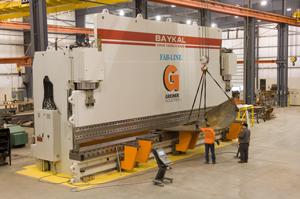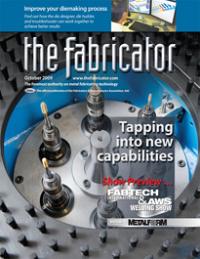Contributing Writer
- FMA
- The Fabricator
- FABTECH
- Canadian Metalworking
Categories
- Additive Manufacturing
- Aluminum Welding
- Arc Welding
- Assembly and Joining
- Automation and Robotics
- Bending and Forming
- Consumables
- Cutting and Weld Prep
- Electric Vehicles
- En Español
- Finishing
- Hydroforming
- Laser Cutting
- Laser Welding
- Machining
- Manufacturing Software
- Materials Handling
- Metals/Materials
- Oxyfuel Cutting
- Plasma Cutting
- Power Tools
- Punching and Other Holemaking
- Roll Forming
- Safety
- Sawing
- Shearing
- Shop Management
- Testing and Measuring
- Tube and Pipe Fabrication
- Tube and Pipe Production
- Waterjet Cutting
Industry Directory
Webcasts
Podcasts
FAB 40
Advertise
Subscribe
Account Login
Search
A giant among machines
Structural steel fabricator installs 40-ft.-long press brake
- By Michael Bishop
- October 8, 2009
- Article
- Bending and Forming
The idea of ordering a 40-foot-long press brake was no problem for Greiner Industries, Mount Joy, Pa. The real work started when the brake was ready for delivery. The company had to find a way to get the mammoth machine to its shop.
The machine, a 2,750-ton Baykal press brake, ordered through Fab-Line Machinery, St. Charles, Ill., had to be transported to the facility in four pieces: two side frames that weighed 88,000 pounds each, as well as a ram and a bed that each weighed 190,000 lbs. Transportation required a truck with 16 axles under each trailer. Each axle had four tires, so the trailer had 64 tires total.
Greiner specializes in structural steel and heavy plate fabrication. It does work for power plants and the mining industry. In the 33 years the company has been in business, it has done structural steel jobs in an industry where the work always seems to be getting larger and heavier. This installation had to set a new standard, however. The assembled press brake weighs more than 800,000 lbs.
"In our shop we do very large, very heavy structural and plate fabrication," owner Frank Greiner said. "So this helps us form heavy and longer plate."
Laying the Foundation
In some ways, the company was ready for the press brake. It already had overhead cranes to move heavy plates. But a lot of foundation work was required to get the building ready.
"The actual foundation is 20 ft. deep, and the concrete is up to 6 ft. thick in certain areas, said Jim Gillespie, manager of business development. "It needed major amounts of reinforcing rod inside that concrete."
Once the press brake was in the brand-new building with a 40-ft.-high roof, Greiner had to use two of its mobile cranes to help put it together. That the facility was finished before the installation actually made the project more difficult. Usually when a shop installs this type of equipment, the roof isn't there, said Gillespie. The equipment is installed before the building is finished. But Greiner had to have the building completed before the equipment arrived.
"That became a major challenge because of the way mobile cranes work; they have to have their outriggers out and you have to be able to get the boom up to a certain height to lift properly," Gillespie said.
Operating the Machine
The biggest difference between this press brake and smaller models is the heavy overhead cranes and lifting devices that are required, Greiner said. Operators don't need any special requirements to run a brake this big. A lot of devices are built into the machine to help simplify use. For example, operators program material thickness, length, and type. If they program the type of material incorrectly, the machine may use much more tonnage to bend than required and, because of a built-in safety feature, automatically stops. The press brake also has built-in sensitivity—any movement within the structure prompts an on-screen indication that the operator may be running the machine incorrectly.
The press brake can 90-degree bend a 1-inch thick Grade 50 steel plate 40 ft. long, helping to eliminate seams and splices. It bends very high-tensile-strength steel, including armor plate. The thickness that it can bend is determined by the punch and die setup for each job. The machine can bend sheets up to 2 in. thick without doing any calculations, but anything thicker than 2 in. needs to be calculated with the manufacturer to ensure the machine won't be damaged.
"The operators have to calculate the tonnage on the punch or they can destroy the punch," Greiner said.
Integrating Capabilities
On its other bending equipment, Greiner can cold-roll plate up to 4 in. thick, structural beams up to 40 in. tall, and square tubing and pipe up to 20 in. in diameter. The company, which offers custom rolling and forming as a stand-alone service, houses all of its bending equipment in the new 40,000-square-foot building. This makes up the company's Rolling and Forming Division.
The press brake has opened up new opportunities for the company, especially because of the capability to bend high-tensile-strength steel and armor plate.
"Having this equipment allows us to get involved in projects we would never have been aware of before," Gillespie said.
Greiner also recently installed a plate processing system with a 160-ft.-long by 16-ft. 8-in. bed. The system cuts with plasma or oxyfuel; drills, taps, and countersinks holes; surface mills; and contour bevels. It provides yet another service that the company can perform on steel plates before the material is bent.
"So we can do the whole process for the customer," Greiner said.
Greiner Industries' recent equipment purchases are helping make it a one-stop shop for customers, which for any steel fabricator is a big accomplishment. But not quite as big as the company's new press brake.
About the Author

Related Companies
subscribe now

The Fabricator is North America's leading magazine for the metal forming and fabricating industry. The magazine delivers the news, technical articles, and case histories that enable fabricators to do their jobs more efficiently. The Fabricator has served the industry since 1970.
start your free subscription- Stay connected from anywhere

Easily access valuable industry resources now with full access to the digital edition of The Fabricator.

Easily access valuable industry resources now with full access to the digital edition of The Welder.

Easily access valuable industry resources now with full access to the digital edition of The Tube and Pipe Journal.
- Podcasting
- Podcast:
- The Fabricator Podcast
- Published:
- 04/16/2024
- Running Time:
- 63:29
In this episode of The Fabricator Podcast, Caleb Chamberlain, co-founder and CEO of OSH Cut, discusses his company’s...
- Industry Events
16th Annual Safety Conference
- April 30 - May 1, 2024
- Elgin,
Pipe and Tube Conference
- May 21 - 22, 2024
- Omaha, NE
World-Class Roll Forming Workshop
- June 5 - 6, 2024
- Louisville, KY
Advanced Laser Application Workshop
- June 25 - 27, 2024
- Novi, MI
































